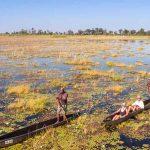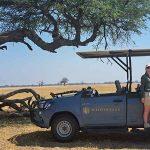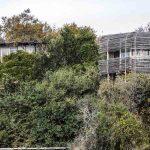I first meet Richard Knocker on a grass airstrip in Ndutu in Tanzania’s Serengeti Plain where my twin prop has to circle low to clear out the giraffes before landing.
He has the reputation of being among the best guides on the continent, which is the reason why I’m here. In an era in which the expert is everything – the yoga guru, the cult ski teacher, the personal travel concierge – I am intrigued that the guide may be becoming more important than the lodging, which has mostly dominated the high-end safari scene.
So here I am, on a six-day walking safari with Knocker in and around Loliondo, a 1,500-sq-mile block of wilderness east of Serengeti National Park in a remote pocket of northern Tanzania. Specifically, we spend most of our time in Piyaya, Masai ancestral lands visited by few outsiders and where there are no permanent commercial lodges. We move our camp twice, our light canvas tents and supplies transported separately by jeep. We wander into the landscape with just a guide, scout, and rifle. There’s also no curfew, meaning we can explore by 4×4 at night.
Knocker, I hope, is the man for the job. As soon as I meet him, it’s clear he’s got charisma. Tall and sun-battered, the 45-year-old Knocker reminds me of a better-looking John Cleese. Sometimes shy, he turns out to be witty and well read in politics, fiction, and popular science. Born in Kenya to English parents, he was educated in Britain. He has been guiding for almost 20 years.
Setting out into the bush, Knocker tells me about the gait of the giraffe. Unlike a horse, he explains, it moves its left legs together, then its right, in an almost comical two-step. I’m only half listening, staring at a hyena skulking through the undergrowth. Knocker is smiling. He’s perfectly at ease, bounding here and there as vultures, secretary birds, and Caspian plovers variously swoop in, all of which he points out with an irresistible enthusiasm.
As we walk out on to the plain, I am overwhelmed. At a guess we see more than 100,000 wildebeest in the first 45 minutes. This is the middle of the migration, when the Serengeti’s wildebeest population is passing through. We see lions satiated beside a kill. Hyenas are lazing close by, their heads dripping blood. Yet it’s not the animals that have gripped me, not at first, but the clouds skimming over the plain, their shadows creating a dramatic, menacing sense of pace, belittling everything beneath them. I have never felt more irrelevant.
That first night, we turn in early, tired from the long journey, under a carpet of bright stars. Yet I am unable to sleep. The ground rumbles with hoofed thunder as herds move around us. I hear cats, the screams of prey, and lost calves calling for their mothers. I am exposed. This is raw, immersive stuff and lying in my tent, I discover my torch is dead. It’s still pointing toward the hole where the zippers don’t quite meet. I take a sleeping pill. I’m in the wilderness with a man I just met who tells me that tomorrow we will go on a Moses walk. “You know, like the parting of the seas,” Knocker had said before we went to bed.
I’ve thought about that all night. I still have no idea what he means.
Trust is a fragile relationship. You can see it in the behaviour of the animals. When you approach in a vehicle, they generally don’t run; they haven’t developed fear of a steel cocoon. But approach on foot and even the biggest cats usually flee. Africa’s wildlife has lived alongside herders for thousands of years. The Masai spear lions as proof of valour. Wander onto a plain packed with grazing wildebeests and the animals gently shift to your left and right. It’s what Knocker meant when he referred to the Moses walk, the act of quietly moving through thousands of wildebeests and gazelles. There’s poetry to it — the stares of the heavy-headed wildebeests, the swirls of birds like tumbling schools of fish. It is intense, confounding, and good to do on the first day. It teaches you who you can trust and who trusts you.
That same morning Knocker takes me to the site of a kill near our camp.
It’s still early, before the day’s thermals have carried the vultures high into the sky. There is blood on the acacia where a lion has pulled a wildebeest into the shade, the red mixed with mud from the recent rains. Hyenas, the can-openers whose work is required before lesser predators are able to get their fill, have cracked the bones into splinters. Now a score of vultures is picking over the remains; they eat more meat in this ecosystem than land-based predators, devouring a quarter of their own body weight in minutes. There are vultures with their Elizabethan ruffs and plumped-up feathered thighs and marabou storks, which look like undertakers. Only the brain remains among the bones.
It doesn’t take long to see what Knocker is up to. He is showing me the pecking order in Africa. He is also encouraging me to understand the difference between being vulnerable, which is respectful of the wildlife, and being scared. It is why when we come up close beside an elephant three days in, Knocker stands beside me, speaking quietly, taking care to explain how the animal behaves. I’m grateful he still remembers how it feels to confront fear.
Johnny Lulu, our local scout, is carrying a .458 Winchester Magnum. He stands between me and the animal – a five- or six-ton bull elephant that eats as much as 650lb a day. Lulu is cool, serene. But his grey-green eyes are watching.
Not so long ago, on safari in another part of Tanzania, Lulu came across an elephant that began following the group’s scent. “I had no other choice. When I turned around, it was coming straight for us,” he recounts. “I knew what was happening, my family has hunted elephant for a long time. Flapping ears and a trunk on the ground, that’s a mock charge. But if an elephant comes at you with its ears back and trunk completely rolled, then it means it. And they move fast. So I did what I had to do. It dropped. It was hard, but essential. The other elephants, 12 in all, surrounded it and didn’t move.”
They say elephants mourn. I can believe it. Standing that close to a bull, with its slow and measured blink, does something to your head. “Lions have their own myth,” whispers Knocker, “but elephants up close, it’s something spiritual.” I am beginning to understand better what this is all about: To do this kind of safari, you have to completely trust the expertise of those you’re with.
Total surrender, I suppose. Only then will you start to connect.
As I relax, I begin to understand Knocker’s instinctive empathy for wildlife and the way he gauges an animal’s state of mind as we approach. “We should be privileged observers,” he says. And not just because the animals can be dangerous. They’re letting us into their territory.
I feel this most acutely during the lion walk. We’re lying low on rocky outcrop, a kopje, the mounds of granite that litter the plain and are often topped by fig trees. Opposite, some 50 yards away, is a lioness and her cub. I can see the colour of her eyes and, through binoculars, the pink of the cub’s nose. When we move too suddenly, they begin to pace with suspicion.
Knocker asks us to retire. To disturb their equilibrium is not our right. “What is crucial, what is fundamental to our approach,” he explains, “is lightness in everything we do.”
We walk for hours, Knocker allowing me to experience the bush at close quarters in a way that is simply impossible by vehicle. I hear whistling thorn, so called because the trees sing when the wind blows through small holes in their bulbous growths. I learn about the southern ground hornbill, “a pickaxe with a brain,” says Knocker, which is one of the leopard tortoise’s predators. I handle obsidian, or volcanic glass, used as tools by early bushmen, and I pick up blister beetles with zany exteriors that resemble Ziggy Stardust suits.
From a blue flower I squeeze water that works as eyedrops, and I observe coupled dung beetles rolling tennis balls of muck that they bury and use to feed their young. We spend 20 minutes examining a single milkweed. Watching a monarch butterfly lay her egg, we find a caterpillar on the same plant. “A whole life cycle on a single bush,” Knocker remarks.
This is a man as enthralled by minutiae as he is by the rare sight of a zorilla, the African skunk. He spots one on a night drive. Meanwhile I’m staring at a moving row of eyes, thousands of red pupils reflecting the lights from our Jeep. It’s the wildebeest, moving past like traffic leaving Manhattan on a Friday night. I breathe it in. Remember this, I say to myself: it will be among the most magnificent moments of your life.






